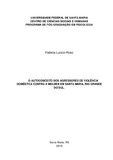| dc.creator | Roso, Patricia Lucion | |
| dc.date.accessioned | 2021-06-23T01:11:48Z | |
| dc.date.available | 2021-06-23T01:11:48Z | |
| dc.date.issued | 2019-04-10 | |
| dc.identifier.uri | http://repositorio.ufsm.br/handle/1/21192 | |
| dc.description.abstract | This research aims to investigate, through psychological evaluation, domestic violence perpetrators against women. To determine if there is an association between sociodemographic profile, attachment types and social desirability, the study uses the Marlowe-Crowne Social Desirability Scale (MC-SDS) as technical instruments; the Next Relationship Scale (ECR-RS); and a Sociodemographic Record. The increasing rates of violence against women in Brazil and in the world, is it important to see the necessity for studies that address this issue. There are a huge literature with data about the victim, however, sparing is the production about the aggressor. In this way, the research aims to contribute with the scientific community and civil society, at the moment that looks at domestic violence with a focus on the aggressor, in an attempt to offer reflections about self-concept, manipulation, attachment and sociodemographic characteristics the executioner's behavior. Thirty female aggressors with a record of occurrence of violence against women in Santa Maria, Rio Grande do Sul were evaluated. The results were treated with descriptive statistical techniques (to analyze sociodemographic data) and inferential, using the chi-square test (to evaluate associations between the types of attachment). Concerning the sociodemographic profile, most of the aggressors have little schooling, are between 30 and 40 years old, are single and have practiced physical and psychological violence, and the reasons for violence are varied. It was verified that the subjects of research tend to present a manipulative behavior, there is a tendency to present with distortion of the self-concept in order to be socially accepted. They are prone to the establish fragile relational bonds of love, with the type insecure attachment worried, which comes from the representational models they had with the maternal and paternal figures. | eng |
| dc.language | por | por |
| dc.publisher | Universidade Federal de Santa Maria | por |
| dc.rights | Attribution-NonCommercial-NoDerivatives 4.0 International | * |
| dc.rights.uri | http://creativecommons.org/licenses/by-nc-nd/4.0/ | * |
| dc.subject | Agressor | por |
| dc.subject | Violência doméstica | por |
| dc.subject | Desejabilidade social | por |
| dc.subject | Apego | por |
| dc.subject | Aggressor | eng |
| dc.subject | Domestic violence | eng |
| dc.subject | Social desirability | eng |
| dc.subject | Attachment | eng |
| dc.title | O autoconceito dos agressores de violência doméstica contra a mulher em Santa Maria, Rio Grande do Sul | por |
| dc.title.alternative | The self-concept of domestic violence aggressors against women in Santa Maria, Rio Grande do Sul | eng |
| dc.type | Dissertação | por |
| dc.description.resumo | A presente pesquisa tem como propósito investigar, por meio de avaliação psicológica, agressores de violência doméstica contra a mulher. Para averiguar se existe associação entre perfil sociodemográfico, tipos de apego e desejabilidade social, o estudo utiliza como instrumental técnico a Escala de Desejabilidade Social de Marlowe- Crowne (MC-SDS); a Escala de Relacionamentos Próximos (ECR-RS); e uma Ficha Sociodemográfica. Tendo em vista os crescentes índices de violência contra a mulher no Brasil e no mundo, atenta-se para a necessidade de estudos que abordem a temática. Vasta é a literatura com dados acerca da vítima, contudo, parca é a produção acerca do agressor. Desta forma, a pesquisa visa contribuir com a comunidade científica e com a sociedade civil, no momento que olha para a violência doméstica com foco na figura do agressor, na tentativa de oferecer reflexões acerca do autoconceito, da manipulação, do apego e de características sociodemográficas o comportamento do algoz. Foram avaliados 30 agressores com registro de ocorrência de violência contra a mulher em Santa Maria, Rio Grande do Sul. Os resultados foram tratados com técnicas de estatística descritiva (para analisar os dados sociodemográficos) e inferencial, através do teste qui-quadrado (para avaliar associações entre as figuras dos tipos de apego). No tocante ao perfil sociodemográfico, a maioria dos agressores possui pouca escolaridade, estão entre os 30 e 40 anos, são solteiros e praticaram violência física e psicológica, sendo variados os motivos geradores de violência. Verificou-se que os sujeitos de pesquisa tendem a apresentar um comportamento manipulador, ou seja, existe tendência à se apresentarem com distorção do autoconceito a fim de serem socialmente aceitos. Apresentam tendência ao estabelecimento de frágeis vínculos relacionais amorosos, com tipo de apego inseguro preocupado, o qual é oriundo dos modelos representacionais que tiveram com as figuras materna e paterna. | por |
| dc.contributor.advisor1 | Vasconcellos, Silvio José Lemos | |
| dc.contributor.advisor1Lattes | http://lattes.cnpq.br/1853136773126959 | por |
| dc.contributor.referee1 | Santos, Samara Silva dos | |
| dc.contributor.referee2 | Cenci, Cláudia Mara Bosetto | |
| dc.creator.Lattes | http://lattes.cnpq.br/6562739264371935 | por |
| dc.publisher.country | Brasil | por |
| dc.publisher.department | Psicologia | por |
| dc.publisher.initials | UFSM | por |
| dc.publisher.program | Programa de Pós-Graduação em Psicologia | por |
| dc.subject.cnpq | CNPQ::CIENCIAS HUMANAS::PSICOLOGIA | por |
| dc.publisher.unidade | Centro de Ciências Sociais e Humanas | por |



